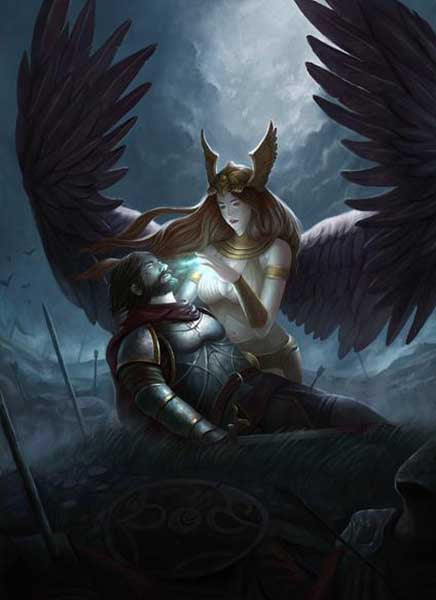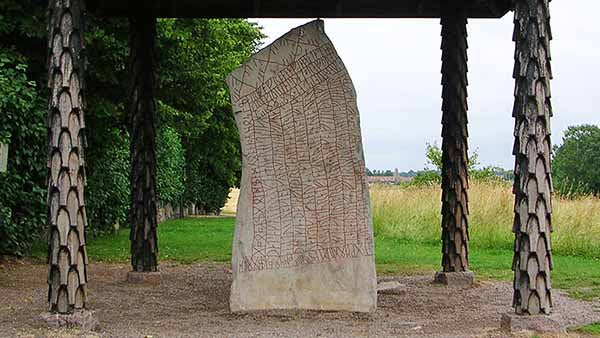Your Cart is Empty
The Valkyries are the most well-known Norse mythological warrior goddesses. They have always been one of the greatest emblems of the Viking people, serving as one of the sacred symbols of Norse beliefs. Just like the most eminent gods of the Norse pantheon, the Valkyries have fueled numerous myths and legends.
Fearsome in war, loyal, proud, and powerful, the Valkyrie epitomizes Viking civilization. According to some myths, she is the mystical source of the legendary strength of the Vikings, especially of Scandinavian women.
In this article, we will uncover the history and origin of the Valkyries, the warrior women who forged the myth of the Vikings and the most powerful fighters in Europe. You will understand the extent of the influence of one of the greatest figures of Scandinavian civilization.

In modern culture, Valkyries are often depicted as elegant women formidable in battle. Adorned in sparkling armor and golden helmets, they wield spears and ride divine winged mounts called Pegasus.
This representation is the most widespread image of the Valkyries. However, it only represents a small part of what these exceptional beings truly were, as this popular image is largely based on paintings and works that date well after the Viking Age.
A typical example is the poem "Darraðarljóð”, written in Old Norse and describing a battle that took place in 1014, long after pagan beliefs had been swept away by Christianity. Similarly, there are works engraved on church pillars that testify to their existence.
Nevertheless, it is accepted that the Valkyries were omnipresent throughout Scandinavian history and are the subject of numerous Norse myths. They are believed to be associated with the folkloric legend of the “Swan Woman”, also found in other civilizations, dating back to 30,000 BC. Tapestries venerating the Valkyries from the Viking era also prove their importance within the Scandinavian people.
To understand the special place they occupied, one must delve into the roots of Scandinavian legends.
In Scandinavian mythology, the pantheon of Norse deities is divided into 3 major families:
The Valkyries are Disir serving the god Odin and Asgard. They will fight alongside him during the great war of Ragnarök. Hence, one of the meanings of their name is: “The Disir who faithfully serve Odin”.

In Norse mythology, the most valiant warriors had the honor of being welcomed into Valhalla, the famous banquet hall of Odin. The Vikings have an unbreakable bond with this sacred god, who was simultaneously the god of protection, strength, and death.
Odin would send his most loyal Valkyries to the battlefields to:

Due to the very mysterious origin of the Valkyries, their name carried a multitude of meanings. However, it has always been related to Odin:
These Viking women were such powerful fighters that Odin honored them with the title of war goddess “Valkyrie.” This title also signifies the purity of these women, as they are most often described as virgins.
These Viking women were such powerful fighters that Odin honored them with the title of war goddess “Valkyrie.” This title also signifies the purity of these women, as they are most often described as virgins.

Viking sagas attest to the existence of female warriors who led great battles, referred to as Skjaldmös. These numerous stories and tales from various Germanic and Scandinavian peoples are believed to be the origin of the legend of the Valkyries:
These legendary women were the origin of myths that depict the power of the Valkyries. Women of iron will, compared to war goddesses, whom nothing and no one could shake.
The Valkyries and the Norns are often confused in Norse mythology, as their skills and abilities are similar and almost identical. The three Norns: Verdandi, Urd, and Skuld weave the fate of every being on the Yggdrasil tree, including that of the gods.
The Valkyries can control the fate of warriors and decide who will perish. It is often difficult to distinguish between their power and that of the Norns. “Skuld,” whose name means “she who sees the future,” is particularly mentioned or compared, on several occasions and in different sagas, to a Valkyrie.

An ancient Icelandic runic text, engraved on a stone called “The Rök Stone” or “Rökstenen,” describes the Valkyries as fierce and bloodthirsty warriors. This is a far cry from the image of them riding the graceful Pegasus often found in modern culture.
This Nordic text depicts them as ruthless war goddesses:
These raven-eyed Viking warriors, riding a horde of wolves, actually embody the power of the father of gods through his two symbols:
These two animals with divine abilities are mentioned repeatedly in Norse mythology. The Valkyrie represents the perfect balance between the two. Merciless in war like the wolf, she forms the link between the world of the dead and the living. With the wisdom of the raven, she holds the privilege of deciding the fate of warriors.
Norse mythology includes the stories of many Valkyries. They played a central role in this civilization. Whether through their sacrifice or their bravery, three Viking warriors are at the origin of the most legendary myths:

The first of the Valkyries, and undoubtedly the most powerful, is none other than the goddess Freya. The famous goddess of love, beauty, and fertility, is also a war goddess. She fought alongside the Vanes in the conflict against the Aesir.
To end this endless struggle, hostages had to be exchanged between the two clans. Freya, being an invaluable asset to Odin's opposing camp, was one of them. However, her abilities and charm quickly promoted her to the rank of an Aesir goddess.
Freya, the Valkyrie goddess, became equal to the god Odin on the battlefield, and led all other Valkyries. She chooses first half of the most valiant warriors and welcomes them to her palace, “Sessrumnir,” located in the realm of “Fólkvangr.” The other half is then escorted by the Valkyries serving Odin to Valhalla.
The goddess Freya rarely wore armor or weapons. However, she possessed attributes with immeasurable powers:
In addition to these gifts, Freya masters divine magic, “Seidr”, which allows women who use it to see the fate of people and change the course of future events to their advantage.
The legend of this Viking skjaldmö is told in “Gesta Danorum,” a book that traces the history of Denmark. The legendary Viking king Ragnar Lodbrok was impressed by the courage and bravery of Lagertha, despite her young age at their meeting.
She led Ragnar to victory and glory, and came to his aid with a fleet of more than 120 ships when he was surrounded by enemies. She became very popular following the broadcast of the television series “Vikings”.
The Völsunga saga and Snorri's Edda tell the story of the legendary Valkyrie Brunehilde and her husband, the legendary hero Sigurd. They embark on numerous adventures and journeys to be reunited, even defying the god Odin.
Comments will be approved before showing up.
